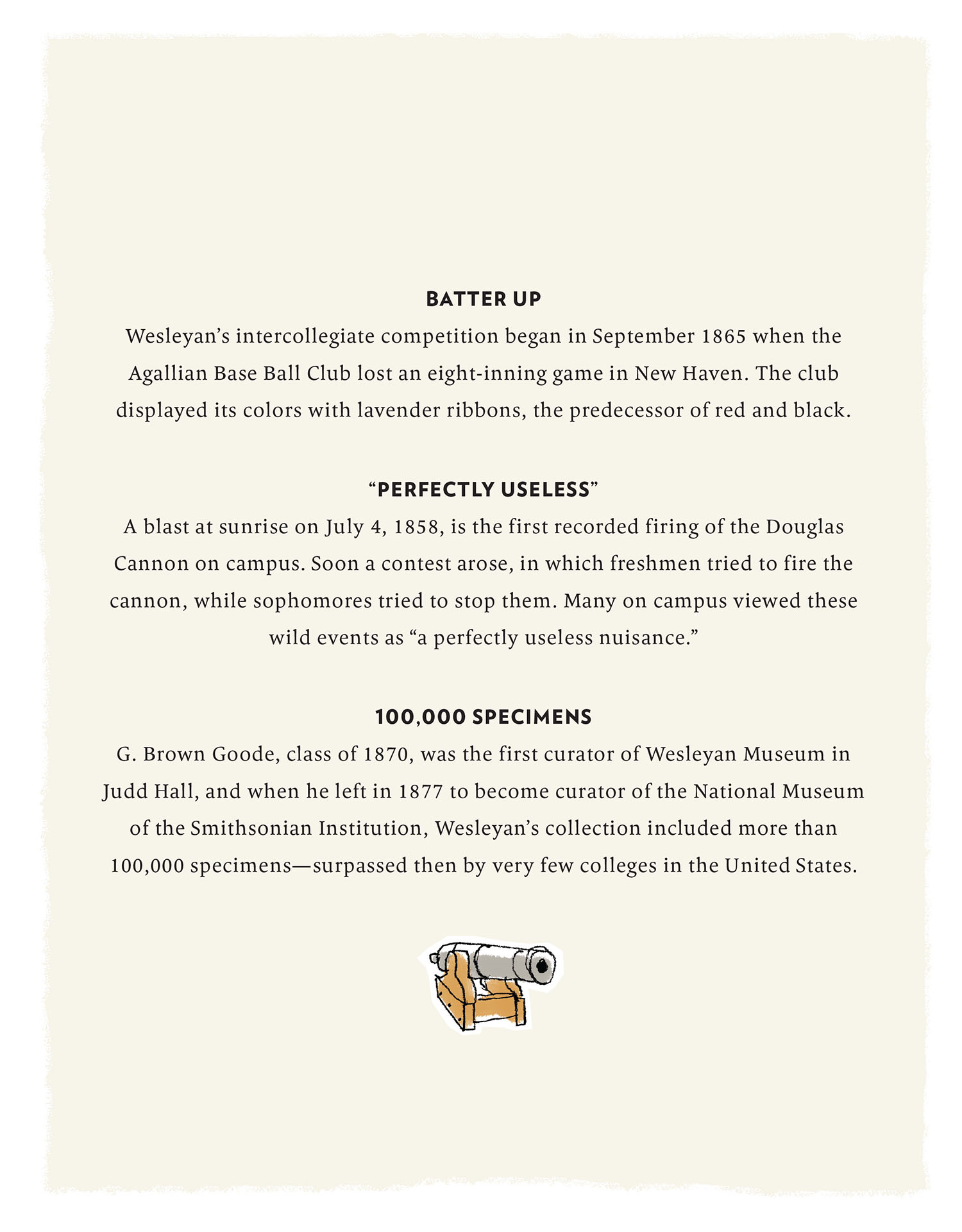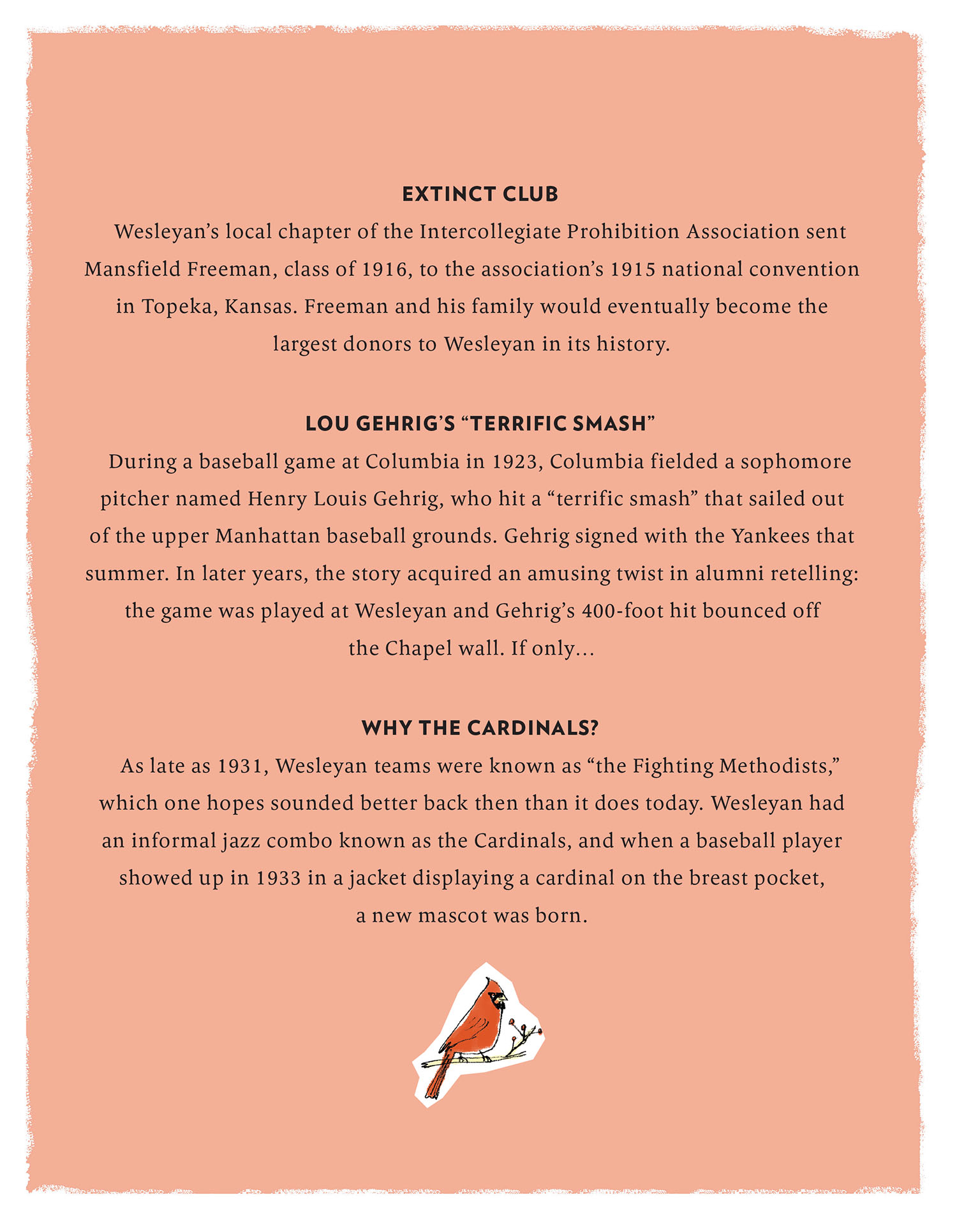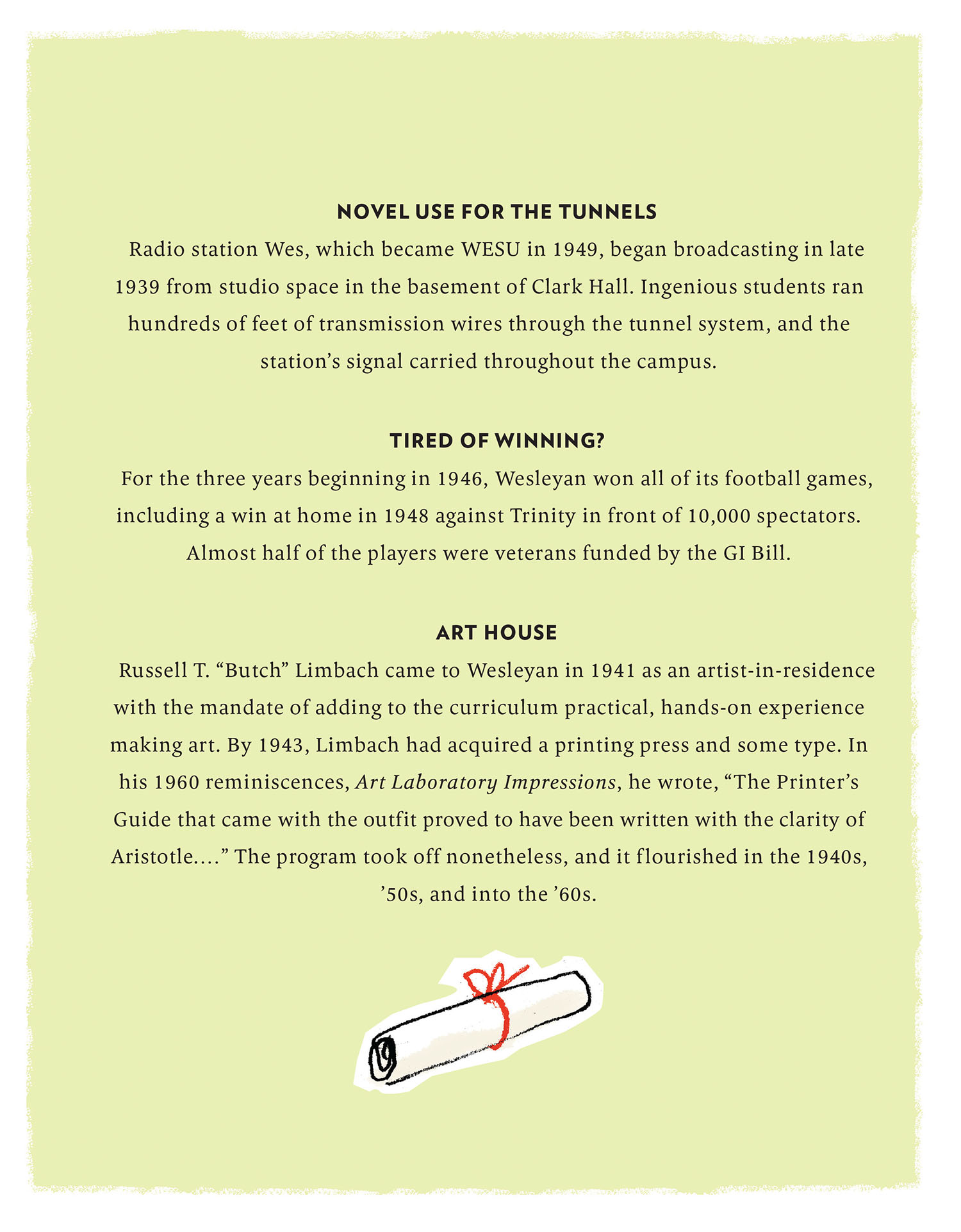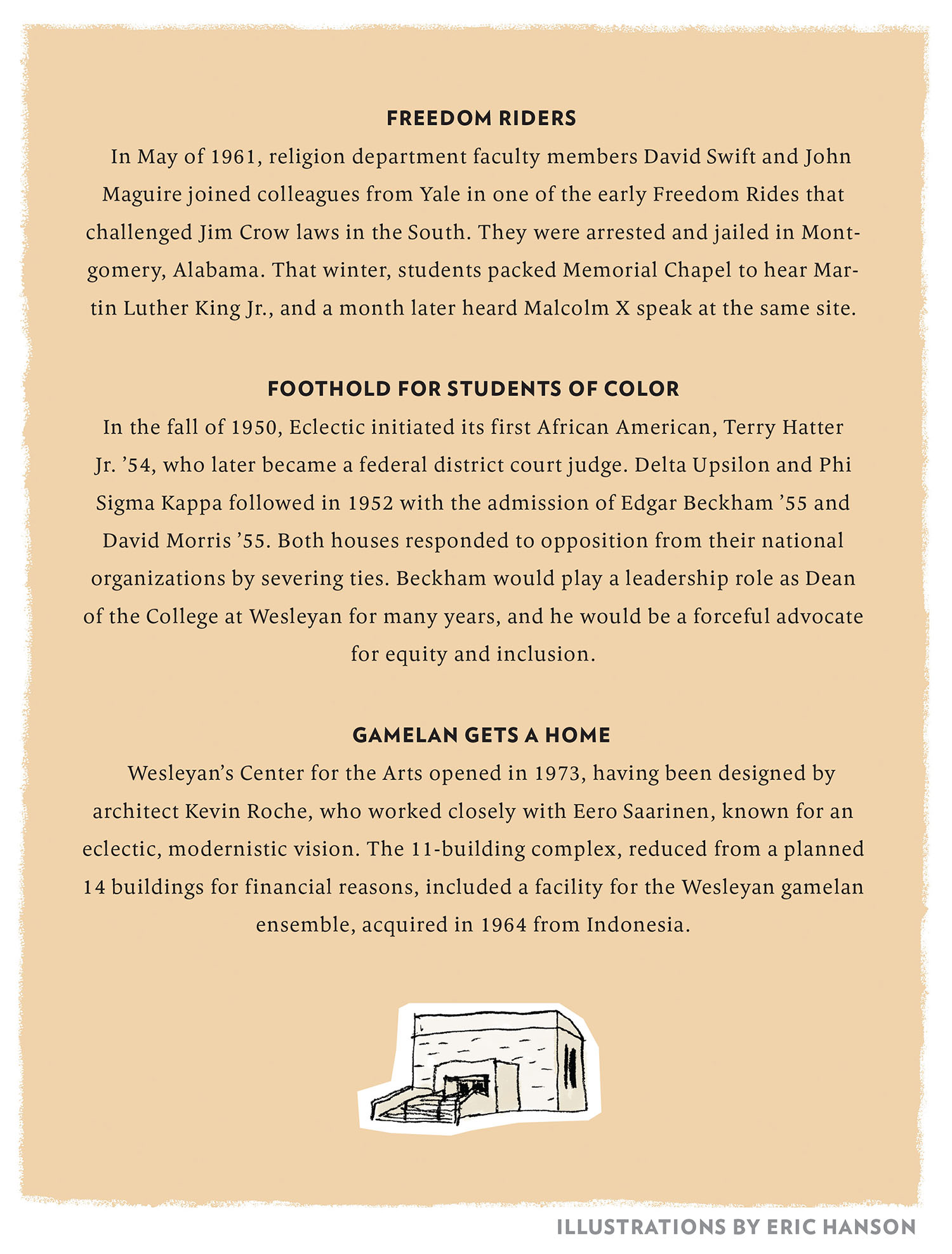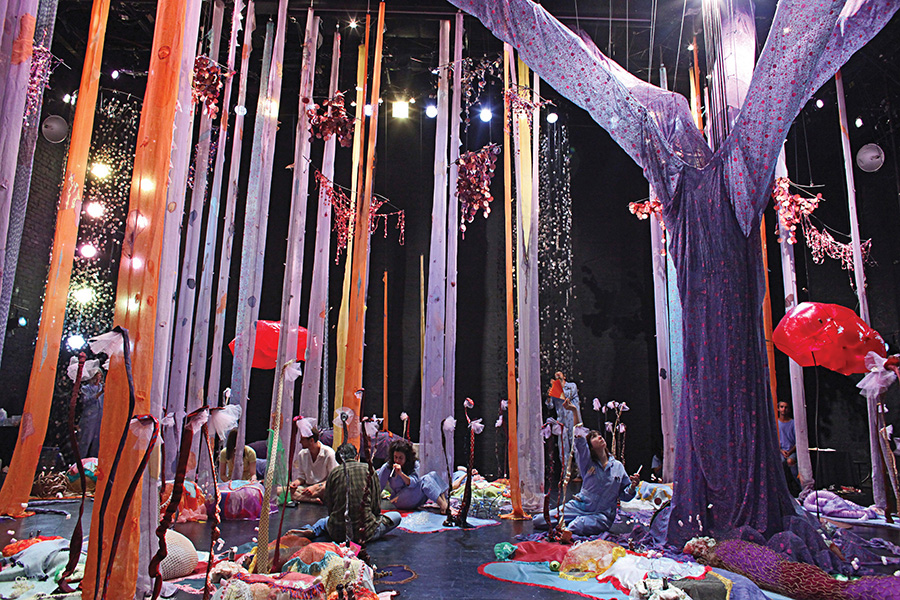ALL YOU NEED TO KNOW ABOUT WESLEYAN HISTORY (NOT REALLY…)

To walk Wesleyan’s campus is to be surrounded by history that whispers from buildings. Presidents left their mark (or didn’t), legendary faculty built Wesleyan’s reputation, controversies raged, student life underwent seismic upheavals—all making Wesleyan what it is today. In the following pages we recount selected points of that evolution, drawing heavily on the insightful histories of Wesleyan written by David Potts ’60: Wesleyan University, 1831–1910: Collegiate Enterprise in New England and Wesleyan University, 1910–1970: Academic Ambition and Middle-Class America. The Wesleyan community is fortunate to have the institution’s history so ably told.
In the Beginning…
Wesleyan’s origins are linked to an unlikely character, Captain Alden Partridge, a man of questionable ethical judgment, who was known for sometimes outrageous behavior as superintendent of the U.S. Military Academy at West Point. He was court-martialed, convicted of insubordination (after defying orders from President James Madison), and forced to resign. Proving that image makeovers are not entirely a modern invention, he managed to establish himself as an educator of students who would be prepared to serve in a standing army, and he persuaded the citizens of Middletown to provide a home for his ambitions.
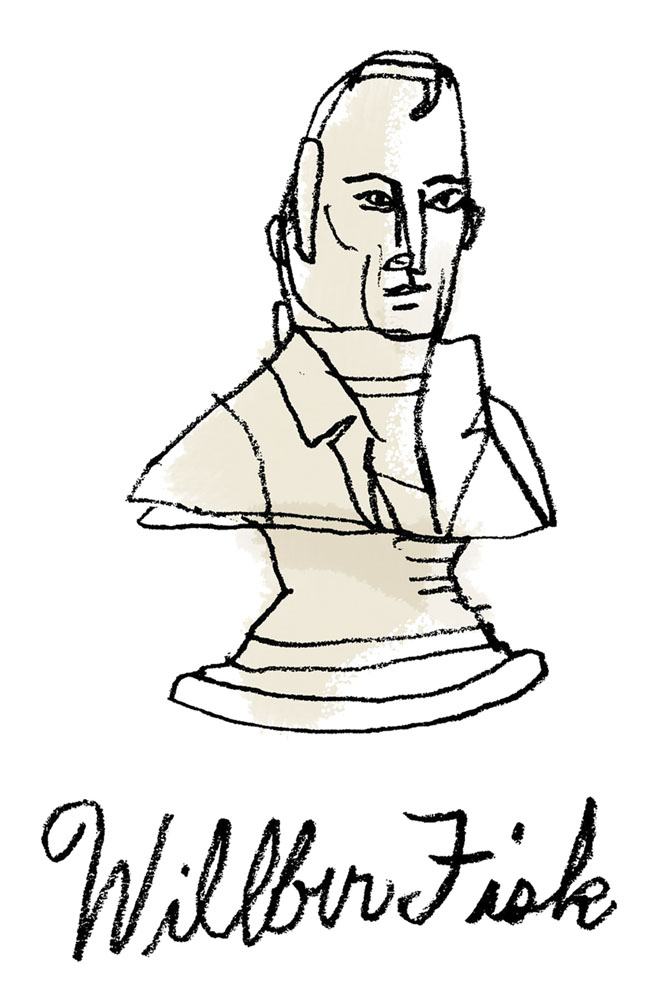 Captain Partridge’s American Literary, Scientific, and Military Academy opened in September 1825, with 300 students from 19 states. After an initial burst of optimism, the academy soon became ensnared in financial difficulties. Partridge was frequently absent as he pursued other ventures, and in 1827 a travel writer who visited the academy described it as filled with undisciplined “ruffians” who were “knee-deep in dirt.” A scant four years after its founding, the academy faded from view.
Captain Partridge’s American Literary, Scientific, and Military Academy opened in September 1825, with 300 students from 19 states. After an initial burst of optimism, the academy soon became ensnared in financial difficulties. Partridge was frequently absent as he pursued other ventures, and in 1827 a travel writer who visited the academy described it as filled with undisciplined “ruffians” who were “knee-deep in dirt.” A scant four years after its founding, the academy faded from view.
Despite such an inauspicious start—or perhaps because of it—leading citizens of Middletown were determined to attract an educational institution, one with a firmer foundation. They forged an agreement with Methodist conferences in New York and New England. In December of 1829, the city of Middletown agreed to provide the Methodists with 15 acres of land, two brownstone buildings with ancillary structures that had belonged to Partridge’s academy, books, chemical apparatus, and approximately $18,000 in subscriptions to purchase stock in the new enterprise. On May 26, 1831, Connecticut Governor John Peters gave his approval for the charter of The Wesleyan University, truly an ambitious name for a modest college.
From the opening of the college on September 21 and throughout his presidency, President Willbur Fisk and the faculty worked to send Wesleyan students “into the world to make it better.” This goal established an enduring Wesleyan hallmark.
What did his friends call Orange Judd…?
No idea, but Orange Judd, class of 1847, is a standout in Wesleyan history as one of the university’s first major donors. In the 1860s Methodist alumni sought to raise funds for Wesleyan, which was gaining a strong denominational identity. Judd stepped forward with the first truly large pledge from an alumnus when he promised to fully fund a new science building. After studying analytical and agricultural chemistry at Yale, Judd had built his journal, the American Agriculturalist, from a circulation of less than 1,000 to more than 100,000 in 1864. His investments in a Long Island railroad enabled him to make the generous pledge to Wesleyan. Subsequent financial reversals left him able to fund only about two-thirds the cost of Judd Hall ($65,000), and Wesleyan used $36,000 in endowment funds to cover the remainder of the cost.
Fortunately for Wesleyan, Judd was not alone and a network of alumni and friends would help to sustain the institution in the ensuing decades.
A warm welcome for women…for about five minutes.
In 1871 coeducation gained approval at Wesleyan in a curious fashion. Orange Judd, then an influential trustee, introduced a resolution to the board stating that “there is nothing in the Charter or By-Laws which precludes the admission of ladies.” That decidedly less-than-ringing endorsement nonetheless cracked the door for women but also challenged any opponents to make their case. None did.
The lack of opposition contrasted starkly with strong resistance at such other all-male preserves in New England as Williams, Amherst, and Dartmouth. Wesleyan could thank faculty members and Methodism’s well-established practice of educating men and women together, as well as five Methodist alumni who had influential positions, including Judd.
Students did not necessarily share such progressive views. When polled on the topic, a large majority of Wesleyan men expressed opposition to coeducation. They called the women’s dormitory the “Quail Roost,” and said their female classmates, “though with us, are not of us.” This bare tolerance with a large dash of bitters would get worse, not better.
A closed door…
The first African American student to enroll at Wesleyan was the last for half a century. Charles B. Ray, a young boot maker from Massachusetts, entered in the fall of 1832 with the intention of becoming a Methodist minister. Encountering a hostile reception from students, he lasted two months. Fisk attempted to protect Ray, but Fisk himself was a proponent of the American Colonization Society, which called for the return of African Americans to Africa. Wesleyan’s trustees passed a resolution limiting admission to white students only, and then rescinded it in 1835, but damage had been done. William Lloyd Garrison’s Liberator published an account and called the Ray case “a scandalous affair.” Ray, who became editor of the Colored American, later spoke in New York about the “heartless prejudice” he experienced at Wesleyan. More than 130 years would pass before Wesleyan would fully open its doors to students of color.
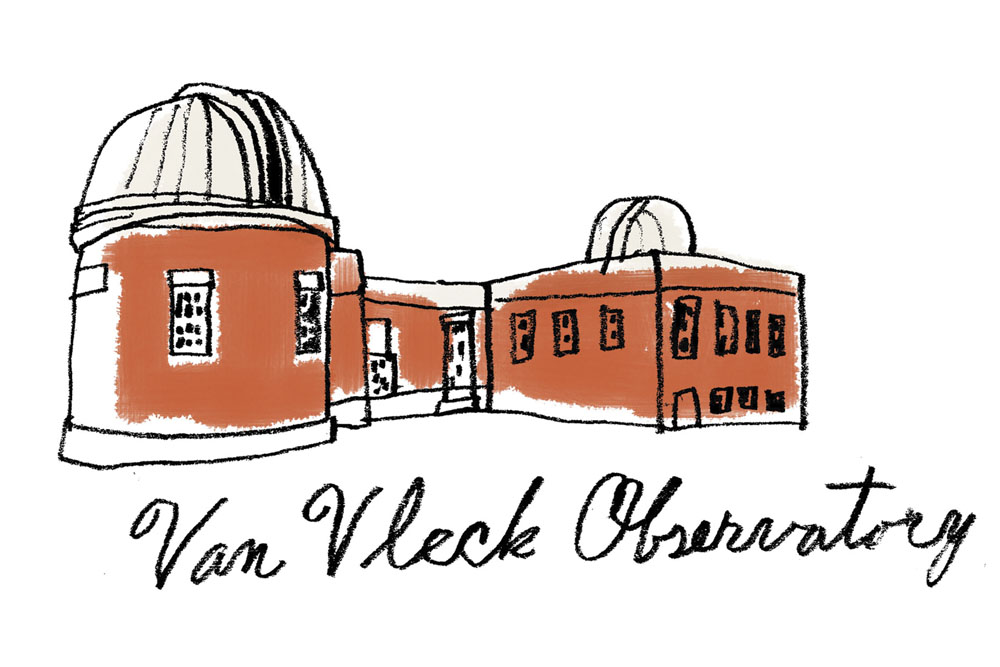 A toast to the calorie…What a difference a professor can make!
A toast to the calorie…What a difference a professor can make!
Four faculty members whose names remain familiar contributed greatly to shaping Wesleyan’s academics in the latter part of the 19th century. John Monroe Van Vleck (class of 1850) was the senior member and mentor to William North Rice, class of 1865, Wilbur Olin Atwater, class of 1865, and Caleb T. Winchester, class of 1869.
The four led Wesleyan’s faculty toward a higher level of professionalism at a time when professors had seemingly endless responsibilities for the minutiae of campus life—involvements ranged from formal religious exercises and athletic supervision to discipline and library management. Faculty gradually shed those encumbrances to focus on professional work.
For the most part, faculty averred from commenting on political issues, but they did speak up on matters related to the educational enterprise. As early as 1837, faculty railed against a bill before the Connecticut General Assembly that would have repealed a law banning circuses, plays, and other performances. The faculty urged retention of legal protection against “the licentious cupidity of strolling players and harlequins.” Later in the 19th century, faculty addressed less quixotic issues by, for example, urging Congress to create an educational institution in China.
By 1881, almost two-thirds of the 20 faculty members had advanced training at German or American universities, and 30 percent had earned doctorates—about equal to that at Harvard. Standards for scholarship were rising, urged on by Van Vleck, who served two years as acting president beginning in 1887. Van Vleck recruited Woodrow Wilson—exactly the kind of talented scholar with impeccable credentials (as seen at the time) who could elevate Wesleyan’s academic reputation, though Wilson soon left for other challenges.
No one on the Wesleyan faculty had a higher national profile, however, than Atwater. His research studying connections between poverty and nutrition exemplified Wesleyan’s tradition of doing good in the world. The highlight of his career and fame came from his study of the human metabolism and his work determining the caloric value of various foods.
“When his experiments turned from ginger snaps to gin in the late 1890s, however, Atwater incurred a deluge of denominational disdain,” as Potts put it. He discovered that alcohol has caloric value, overturning claims to the contrary from the Methodist-backed temperance movement. Atwater was both a loyal Methodist and one of the best-known scientists of his day, so his findings were front page news in major metropolitan dailies. The controversy he ignited raged for the next four years and may have contributed to his early death from a stroke in 1907. Atwater received strong support on campus, perhaps foreshadowing the break with Methodism that was to come.
Curricular course correction…
Revisions to the curriculum in 1873–74 are long since forgotten, but they steered Wesleyan in important new directions. Classical language requirements were reduced in favor of electives to provide “more practical preparation for the duties of life,” but perhaps more important was the shift, directed by faculty, toward a curriculum that valued research. In 1886, for example, the faculty moved introductory courses in science closer to the first year so that students would have more opportunity to explore rapidly changing scientific fields. Faculty brought specialized knowledge into the classroom that could not be found in textbooks.
Wesleyan’s new science building, Judd Hall, symbolized this shift, as did Observatory Hall, which housed a 12-inch refractor telescope acquired by Van Vleck. At the laying of the cornerstone for Judd in 1870, the main speaker, a scientist from the University of Michigan, predicted that science courses would soon surpass instruction in classical languages. In Judd Hall, students greeted the introduction of lab instruction in chemistry by arriving early and leaving late. There was perhaps no better indicator of future trends.
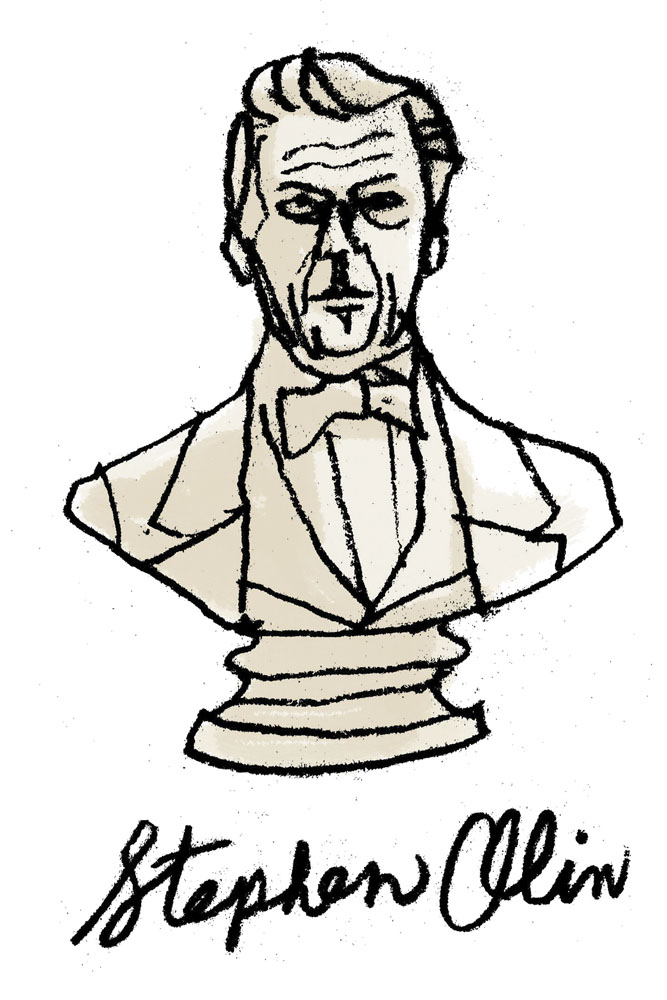 What a difference a trustee can make…
What a difference a trustee can make…
The unsmiling bust of Stephen Henry Olin, class of 1866, graces the imposing foyer of Olin Library, but surely he has reason to be pleased. Perhaps no one has had a more enduring impact on the physical structure of campus than this urbane New York City attorney who served as a Wesleyan trustee from 1880 to 1925. Throughout his adult life, Olin championed Wesleyan in New York’s high society, and at Wesleyan he was revered.
In 1891, the campus consisted of little more than the brownstone row constructed by Middletown and subsequently the Methodists. Under Olin’s leadership as chair of the board’s committee on buildings and grounds, the modern Wesleyan began to take shape. He brought in major architects from New York City, starting with J.C. Cady, architect of the Metropolitan Opera House and the south wing of the American Museum of Natural History, to design Fayerweather Gymnasium. North College lawn, which had been untended pasture, became a mowed lawn with beautiful trees.
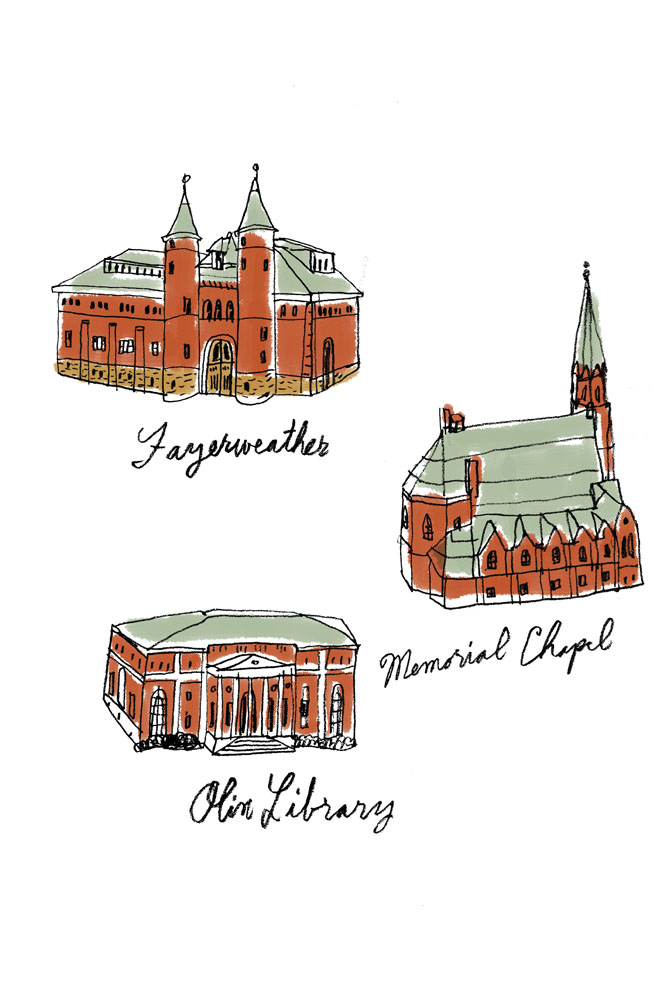 Fisk Hall, completed in 1904, offered a modern infrastructure within its Romanesque brownstone facade. Adorned with Beaux Arts Classicism, The John Bell Scott Memorial (now Allbritton Hall), also opened that year and supplied ample facilities for the Physics Department. Fraternity houses filled the southern and eastern borders of the campus, including Psi Upsilon, which initiated in 1893 a new generation of major buildings for chapter houses. Members boasted that they had “the model college fraternity club house.” Chi Psi Lodge and Alpha Delta Phi soon followed, and construction of Eclectic House in 1907 brought Henry Bacon (who would become the architect of the Lincoln Memorial) into Wesleyan’s orbit as campus architect well into the 1920s. North College, then a dormitory, burned to the ground in 1907 and was replaced by a similar building but with finer construction and architectural detail, as well as an additional floor. During this period Wesleyan also acquired property and a spacious Italianate villa for the president’s house.
Fisk Hall, completed in 1904, offered a modern infrastructure within its Romanesque brownstone facade. Adorned with Beaux Arts Classicism, The John Bell Scott Memorial (now Allbritton Hall), also opened that year and supplied ample facilities for the Physics Department. Fraternity houses filled the southern and eastern borders of the campus, including Psi Upsilon, which initiated in 1893 a new generation of major buildings for chapter houses. Members boasted that they had “the model college fraternity club house.” Chi Psi Lodge and Alpha Delta Phi soon followed, and construction of Eclectic House in 1907 brought Henry Bacon (who would become the architect of the Lincoln Memorial) into Wesleyan’s orbit as campus architect well into the 1920s. North College, then a dormitory, burned to the ground in 1907 and was replaced by a similar building but with finer construction and architectural detail, as well as an additional floor. During this period Wesleyan also acquired property and a spacious Italianate villa for the president’s house.
In 1912 Olin enlisted Bacon to create Wesleyan’s first comprehensive campus development plan, which called for a Beaux Arts formal quadrangle behind College Row. Elements of the plan would be adopted, but the quadrangle would never be realized in the way Bacon envisioned.
Not just conviviality…
As the 20th century dawned, Wesleyan’s student body was changing. Students were less likely to be Methodist and more likely to be children of professionals than of farmers and tradesmen. Roughly 90 percent belonged to the seven fraternities, which provided comfortable accommodations and relaxing evenings of fun, conversation, and singing. In libraries and lounges, members and guests would gather for such male-oriented events as “smokers.” Fraternities also prepared men for urban life and membership in influential men’s clubs; young men learned how to comport themselves in a realm where masculinity was venerated. Deeply embedded in campus life, fraternities had the full support of the faculty and administration. Noticeably absent—women.
Ladies, adieu…
At the turn of the century, discrimination against women in campus social life was overt; there was nothing subtle about it. They were denied access to the new gymnasium, excluded from being class officers, excluded from class pictures, and generally treated with contempt by many men. Male students and alumni alike were alarmed when the number of first-year women jumped from seven in 1891 to 24 (23 percent of the class) in 1898. Women created a largely separate life for themselves, with an array of literary and social enterprises, including their own class day observances during commencement week.
 The rise in the number of women—with some hyperbole referred to as the “feminization” of Wesleyan—cranked up the emotional intensity of debate about coeducation. In true academic fashion, trustees established a committee to consider the matter. Stephen Olin was among the strongest opponents of coeducation (and spoke about “the weaker sex” in ways that would evoke fury today), while Van Vleck was the most influential proponent of coeducation. The committee deliberated during much of 1889–90 and received a recommendation from just one group, the New York Young Alumni Club, which expressed fear for the future of the masculine character of the university and urged that Wesleyan establish a women’s college within the university.
The rise in the number of women—with some hyperbole referred to as the “feminization” of Wesleyan—cranked up the emotional intensity of debate about coeducation. In true academic fashion, trustees established a committee to consider the matter. Stephen Olin was among the strongest opponents of coeducation (and spoke about “the weaker sex” in ways that would evoke fury today), while Van Vleck was the most influential proponent of coeducation. The committee deliberated during much of 1889–90 and received a recommendation from just one group, the New York Young Alumni Club, which expressed fear for the future of the masculine character of the university and urged that Wesleyan establish a women’s college within the university.
The board punted with a decision that pleased no one: maintain the status quo with a 20 percent cap on admitted women. The board made it clear that Wesleyan would be primarily a men’s college. It wasn’t long before agitation against women turned ugly with direct harassment, offensive language, and hostile painted messages. Alumni believed Wesleyan’s reputation was suffering due to the presence of women, and they cited statistics showing healthy enrollment increases at competitor institutions, while Wesleyan’s enrollment had actually decreased over the decade. In such an atmosphere, the end was clearly near and no one was surprised when the board voted to cease admitting women after 1909. The New York Times said that “Wesleyan’s authorities have acted wisely.” The last four women undergraduates received their degrees in 1912.
Pro-coeducation forces gained one feeble concession: the board would consider establishing a coordinate college for women if funds could be raised. While Wesleyan dickered, New London acted with an offer of land, buildings, and endowment made to an influential women’s group in the state led by a Wesleyan alumna, and Connecticut College for Women was born.
Vote Republican…
By 1920 the student population was about 530, and Wesleyan had begun to use selective admissions. Nonetheless, only 44 percent of students came from the top third of their graduating class. Unlike today, most were moderately conservative. In the presidential election of 1912, a poll of students revealed that only 16 percent supported Woodrow Wilson, despite his status as a former faculty member! Later, in 1960, students would favor Richard Nixon—the last gasp of the conservative campus.
The “Little Three” catches on…
Although Wesleyan could not yet consistently attract top students, the reputation of its faculty was on the rise. In the second edition of American Men of Science (1910), Wesleyan ranked in the top 10 for most measures of first-rate faculty in science.
 A national study of 344 institutions prepared for the U.S. Bureau of Education placed Wesleyan among 59 colleges and universities in the top category—information that made its way into newspapers in 1912. One study found that Wesleyan’s ratio of enrollment to alumni earning PhDs was better than ratios for Amherst or Williams. The New York Times prominently listed Wesleyan along with Williams, Amherst, Yale, and Harvard as a recipient of grants from Rockefeller’s General Education Board.
A national study of 344 institutions prepared for the U.S. Bureau of Education placed Wesleyan among 59 colleges and universities in the top category—information that made its way into newspapers in 1912. One study found that Wesleyan’s ratio of enrollment to alumni earning PhDs was better than ratios for Amherst or Williams. The New York Times prominently listed Wesleyan along with Williams, Amherst, Yale, and Harvard as a recipient of grants from Rockefeller’s General Education Board.
Walter Cady, who gained national prominence in solid state physics, exemplified faculty members who pushed Wesleyan toward excellence in research. In 1928, the Institute of Radio Engineers awarded him a prize for his groundbreaking work in piezoelectric phenomena and their application to radio technique, which enabled radio networks to control broadcast frequencies with much greater accuracy.
Another boost to Wesleyan’s reputation came through Little Three competition. A reporter for the Springfield Republican appears to have coined the term “Little Three” in 1921, and within two years The New York Times was referring to Williams as a Little Three champion beneath the listing of Yale as the Big Three champion. This informal association soon spread beyond athletics—much to Wesleyan’s benefit, since Williams and Amherst generally had stronger reputations.
Books, books, and more books…
Olin Library was Stephen Olin’s crowning achievement. The library, with about 18,000 volumes, had migrated from the basement of South College to Rich Hall (now Patricelli ’92 Theater) in 1868. Subsequent growth of the collection to more than 70,000 volumes overwhelmed the capacity of Rich Hall. Olin urged construction of a new building in his 1913 report, which included the Bacon campus plan and a location for the library, which it now occupies. But it would take a change in the presidency to move this project forward. Influential board members had engaged in a failed attempt to dislodge William Shanklin from the presidency, but by 1922 his health was failing, which provided the board with an excuse to grant him a leave of absence—one that he had not requested. Shanklin was packed off to Europe with a travel allowance, and Olin became acting president for a year. He used his contacts in New York to enliven the campus cultural life in what became celebrated as “The Olin Year.”
 In 1925 James McConaughy became Wesleyan’s 10th president. He was a practical executive of imposing height, with a well-modulated voice and a self-assured manner. His selection was well received on campus and by alumni, including one in particular: Olin. He and his wife, Emeline Harriman Olin, pledged anonymously to fund more than half the cost of a magnificent new library. Olin traveled in a private railroad car from New York with Emeline to witness the groundbreaking, but she wielded the shovel because he was mortally ill and would not live to see construction started.
In 1925 James McConaughy became Wesleyan’s 10th president. He was a practical executive of imposing height, with a well-modulated voice and a self-assured manner. His selection was well received on campus and by alumni, including one in particular: Olin. He and his wife, Emeline Harriman Olin, pledged anonymously to fund more than half the cost of a magnificent new library. Olin traveled in a private railroad car from New York with Emeline to witness the groundbreaking, but she wielded the shovel because he was mortally ill and would not live to see construction started.
At the request of trustees, Emeline reviewed the McKim, Mead & White plans for the building, which were based on Bacon’s design. In addition to her homes in New York and Newport, Rhode Island, she acquired quarters on the edge of campus so she could keep a watchful eye on construction. At the dedication ceremony in 1928, she presented McConaughy with keys to the building, which was 10 times the size of Rich Hall and had capacity for 300,000 books. Its Vermont marble portico, six Ionic columns, and elaborate pediment gave the building an elegant, imposing exterior. Its Renaissance-style Memorial Hall welcomed visitors with green Italian marble, a marble mosaic floor, and paneling in Italian walnut—all of which bore a striking resemblance to the central hall of the University Club in New York City, also designed by McKim, Mead & White. As a symbol of a university on the rise, Wesleyan could hardly have done better.
Forget about Amherst and Williams…
Victor L. Butterfield’s arrival at Wesleyan in 1935 would become a landmark event. As a Cornell undergraduate, however, Butterfield’s most impressive accomplishments were not in the classroom but on the football field, where he was varsity quarterback of a nearly undefeated team.
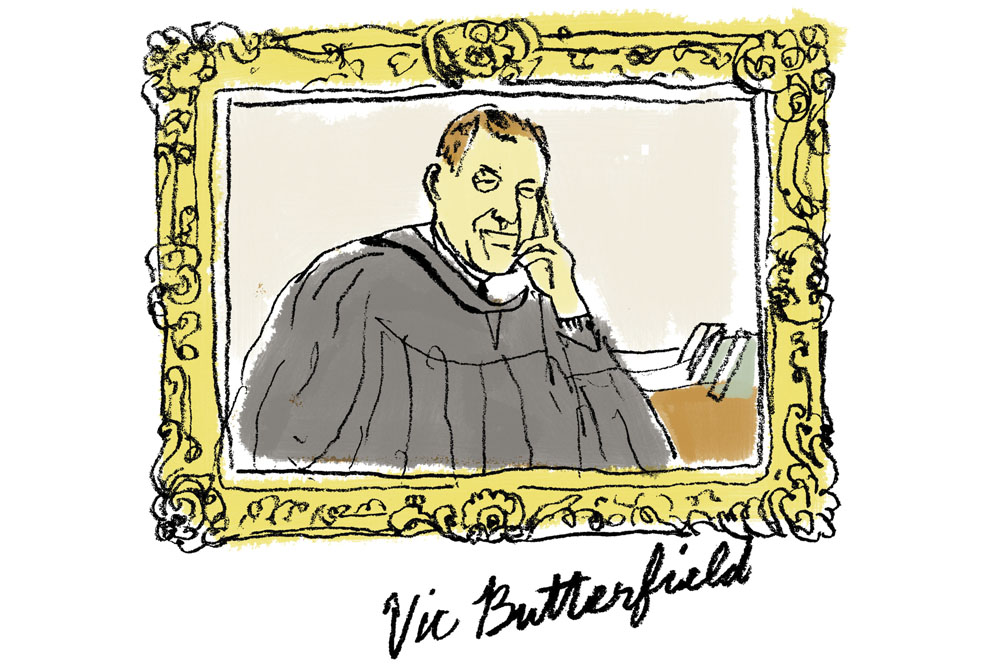 As Wesleyan’s new admission director, he established the university’s first professional process for student recruitment and selection. He personally interviewed every applicant and looked for young men who demonstrated “an ability to handle ideas.” He reached out to Wesleyan’s alumni network for help in recruitment. Early results of his efforts were modest, at best, and Wesleyan lagged Amherst significantly in the academic quality of entering students. Despite these lackluster results, Butterfield’s leadership abilities, his commitment to liberal education, and his wide-ranging intellect were rapidly becoming apparent to colleagues.
As Wesleyan’s new admission director, he established the university’s first professional process for student recruitment and selection. He personally interviewed every applicant and looked for young men who demonstrated “an ability to handle ideas.” He reached out to Wesleyan’s alumni network for help in recruitment. Early results of his efforts were modest, at best, and Wesleyan lagged Amherst significantly in the academic quality of entering students. Despite these lackluster results, Butterfield’s leadership abilities, his commitment to liberal education, and his wide-ranging intellect were rapidly becoming apparent to colleagues.
With foresight, Butterfield argued in a long memorandum to President McConaughy that Wesleyan should “forget about Amherst and Williams,” concentrating instead on setting its own goals and doing everything possible to achieve high educational quality. He would follow that path remarkably well.
An amicable divorce…
Wesleyan formally severed its ties with the Methodist Conference in 1937, much like a couple who had drifted apart over time and opted finally to acknowledge what was already obvious. Most telling was the poor attendance records of many conference-elected trustees. The board approved a “discontinuance” of conference-elected trustees, and the Connecticut legislature ratified this action as a charter amendment. More than a century of affiliation with the Methodist Conference ended quietly and cordially.
The charter change was led by board chair George W. Davison, class of 1892. A long and devoted friend of Stephen Olin, Davison assumed the role of seeking greater recognition for Wesleyan. Removing what he saw as the impediment of denominational affiliation was but a step toward that goal.
Davison’s service as board chair was lengthy: 1928–’43. He led Wesleyan through its centennial celebration and the Great Depression. He selected Victor Butterfield, Wesleyan’s longest-serving and most transformative president. His bequest of $6.3 million (worth $58.6 million today) in 1953 almost doubled the book value of Wesleyan’s permanent endowment funds and, as with his earlier gifts, supported many of Butterfield’s achievements.
Foresight in the war years…
Butterfield became president in 1943 and retired 24 years later in 1967. During this astonishingly long tenure he was able to reshape the faculty in ways that would be impossible today, when presidents do not exercise the kind of authority over hiring afforded to him.
He began this effort at a most unlikely time, when Wesleyan nearly had to close its doors. By fall of 1943 there were a scant 153 civilian undergraduates on campus, and that number would fall again the next year to about 100. By late 1942, more than 50 of the nation’s small colleges had closed and an equal number were flirting with bankruptcy. At a critical moment, President Roosevelt called for the military to initiate officer training programs at small colleges. Wesleyan benefited by the establishment of a naval V-5 preflight training program and a V-12 program for future deck officers. The programs stabilized Wesleyan’s financial situation and enabled its new president to think about the future in a bleak period.
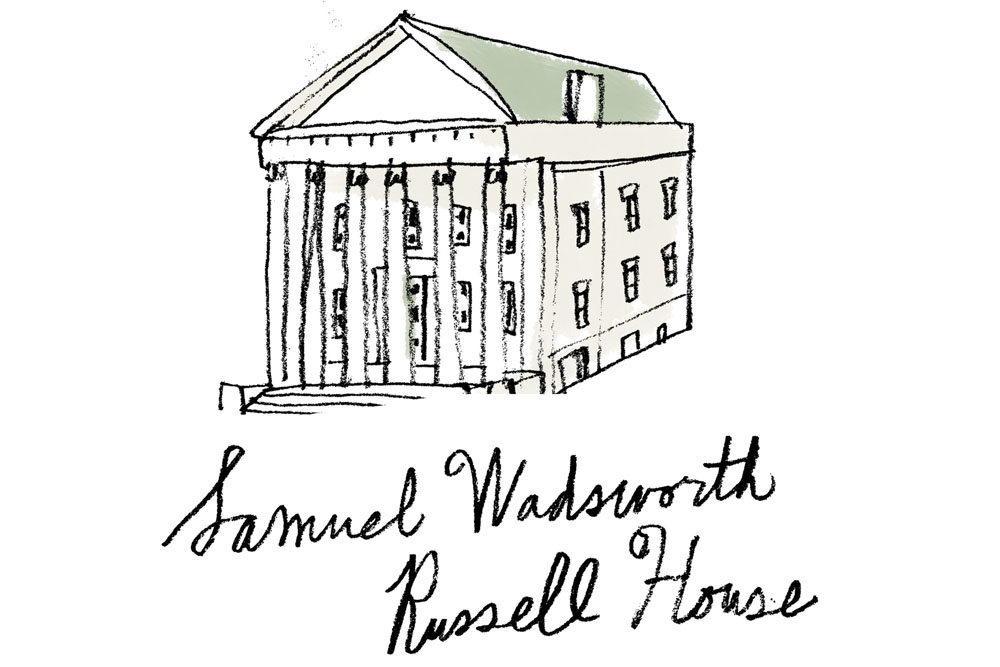 In the difficult mid-war years, he began tapping sources from all over the country for potential faculty members—each “an able scholar, broad in his interests and profound in his understanding.” A commitment to liberal education and a “flair” for arousing student enthusiasm were also indispensable, according to Potts. When the post-war recruiting season opened, Butterfield had a file on more than 200 of the most promising young teacher-scholars, which he was able to draw upon for many years to come as most of the faculty roster turned over. The results included such faculty members as Carl Schorske in intellectual history and Norman O. Brown in philosophy (both former OSS officers); David McAllester, a pioneer in ethnomusicology; Samuel Green in art history; and Norman Rudich in Romance languages, to cite just a few Butterfield recruits whose influence would be felt by generations of Wesleyan students.
In the difficult mid-war years, he began tapping sources from all over the country for potential faculty members—each “an able scholar, broad in his interests and profound in his understanding.” A commitment to liberal education and a “flair” for arousing student enthusiasm were also indispensable, according to Potts. When the post-war recruiting season opened, Butterfield had a file on more than 200 of the most promising young teacher-scholars, which he was able to draw upon for many years to come as most of the faculty roster turned over. The results included such faculty members as Carl Schorske in intellectual history and Norman O. Brown in philosophy (both former OSS officers); David McAllester, a pioneer in ethnomusicology; Samuel Green in art history; and Norman Rudich in Romance languages, to cite just a few Butterfield recruits whose influence would be felt by generations of Wesleyan students.
Sadly, Wesleyan was not ready to lead the way in hiring women or faculty of color.
The deal of a lifetime…
Wesleyan has no buildings named after Stuart Hedden, class of 1919, which is a surprising omission for the principal architect of Wesleyan’s financial prosperity. A protégé of George Davison, Hedden chaired the board’s finance committee from 1942 to 1955. He used that perch to lead Wesleyan’s acquisition of American Education Press Inc. in 1949. Its flagship publication was My Weekly Reader. As the post-war baby boom generation filled the ranks of elementary schools with avid young consumers of My Weekly Reader, Wesleyan’s investment blossomed into an extraordinary source of income.
Renamed the Wesleyan University Press, this investment also created an immense headache that never truly went away. From the outset Wesleyan’s investment appeared to run afoul of federal legislation that prohibited nonprofits from acquiring businesses unrelated to their principal mission. Hedden used all his considerable political skill and contacts in Washington to obtain an exemption for the Press, known as the “Wesleyan Amendment.” Congress passed the amendment but in a form that left Wesleyan vulnerable to future IRS action.
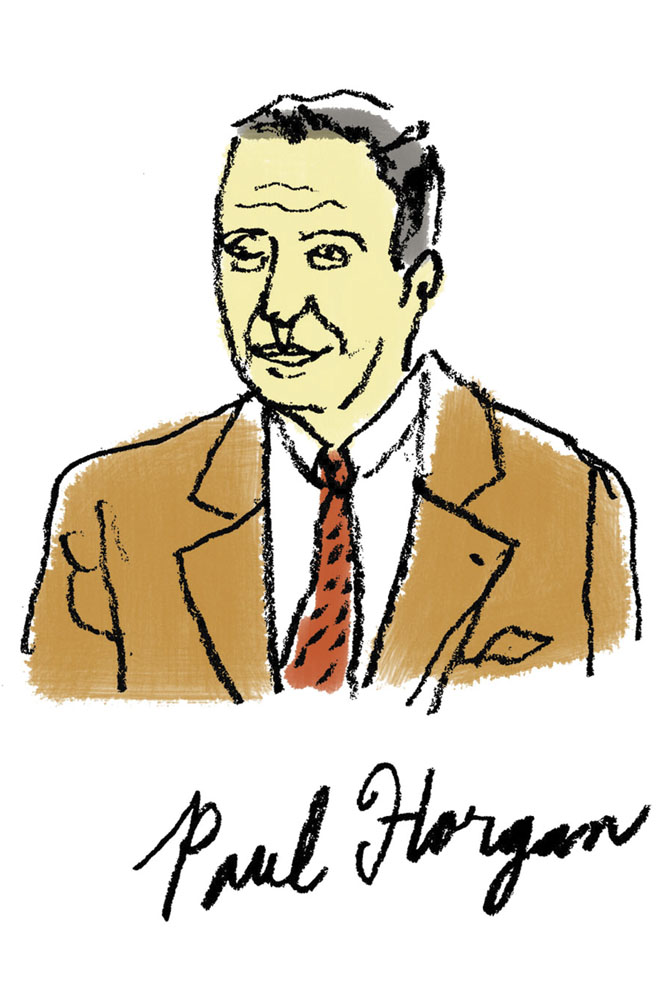 By 1958–’59, the Press was generating $4 million for Wesleyan coffers—then an extraordinary sum that lifted Wesleyan into the top-tier ranks of American colleges. The Butterfield administration enjoyed its heyday as admissions surged, facilities improved, and curricular experimentation won national recognition. Wesleyan’s lofty ambitions in the late 1950s shone brightly in the creation of the Center for Advanced Studies, which would soon be directed by Pulitzer Prize winner Paul Horgan. Butterfield saw the center as a gem for Wesleyan’s reputation, with such visiting scholars as Hannah Arendt, René Dubos, C.P. Snow, and Edmund Wilson. Wesleyan faculty were less entranced. They saw the center as apart from them and yielding little benefit to Wesleyan’s educational enterprise. These discontented rumblings were a harbinger of more difficult problems Butterfield would face with the faculty he recruited.
By 1958–’59, the Press was generating $4 million for Wesleyan coffers—then an extraordinary sum that lifted Wesleyan into the top-tier ranks of American colleges. The Butterfield administration enjoyed its heyday as admissions surged, facilities improved, and curricular experimentation won national recognition. Wesleyan’s lofty ambitions in the late 1950s shone brightly in the creation of the Center for Advanced Studies, which would soon be directed by Pulitzer Prize winner Paul Horgan. Butterfield saw the center as a gem for Wesleyan’s reputation, with such visiting scholars as Hannah Arendt, René Dubos, C.P. Snow, and Edmund Wilson. Wesleyan faculty were less entranced. They saw the center as apart from them and yielding little benefit to Wesleyan’s educational enterprise. These discontented rumblings were a harbinger of more difficult problems Butterfield would face with the faculty he recruited.
In the end, the uncertain tax status of revenues from the Press, combined with rising costs of running the business, led Wesleyan to sell it in 1965. The diversification-minded Xerox Corporation agreed to acquire the Press in exchange for 400,000 shares of Xerox stock. Wesleyan’s total net gain from its original investment in the Press would eventually reach $129 million. From this Hedden-led purchase and his tireless work to hold the IRS at bay, along with $23 million realized from investment decisions he made as chair of the Finance Committee, this trustee increased Wesleyan’s assets by more than $1 billion in today’s dollars.
Revving up admissions…
While Wesleyan was hiring star faculty members, efforts to improve the academic credentials of admitted students had lagged. That began to change in 1953 with the arrival of Robert Norwine as director of admission. Just four years out of college himself, Norwine’s challenge was to find those students who defied the stereotype of the post-war “Silent Generation,” a pre-baby-boom cohort seen as lacking in intellectual adventurousness and seeking merely safe passage into a corporate, suburban lifestyle. Norwine had help from demographics: a rapidly rising number of young people were seeking a college education. He expanded the admission staff and deployed staff on travel across the country to educate secondary school counselors about Wesleyan. Revenues from the Press helped decisively. Wesleyan was able to significantly increase its scholarship budget, an invaluable aid to recruitment. Financial aid for the class entering in 1956 rose by 67 percent over the amount budgeted for the previous class. Average College Board verbal scores began to climb and soon exceeded those for entering classes at Williams and Amherst. By the early 1960s, Wesleyan was fully competitive in the Little Three in every sense and occupied a position of financial superiority.
Butterfield versus the Little University…
Under Butterfield, Wesleyan had risen to an enviable position as one of the nation’s leading liberal arts colleges. But his vision for the future had begun to diverge significantly from that of the faculty. Butterfield was a strong proponent of the College Plan, exemplified by the College of Letters and the College of Social Studies, founded in 1959, which were then residential as well as academic colleges. He hoped to build on that model and extend it across the university, anchoring Wesleyan in his expansive vision of liberal arts education, which called on faculty to be much more than specialists in their fields. The university-based model of specialization, however, was in the ascendancy, especially in the sciences. Butterfield’s vision would not prevail.
A group of faculty members informally dubbed “the Mystic Nine” (a playful allusion to the Mystical Seven Society) issued a four-page report in 1961 calling on Wesleyan to become “a major new American university” with doctoral programs. All were Butterfield appointments, including Robert Rosenbaum, who would become the chief proponent of the “little university.” The Mystic Nine argued that leadership in higher education was shifting to graduate universities and that Wesleyan would fall behind if it did not live up to the “university” in its name with graduate programs and a faculty devoted to research. Despite his deep misgivings, Butterfield eventually acquiesced to faculty insistence on graduate programs. Troubled with health problems, Butterfield was worn down by his long tenure as president. Faculty members were energized and had gained a strong voice by working directly with board members.
Change comes to the academy…
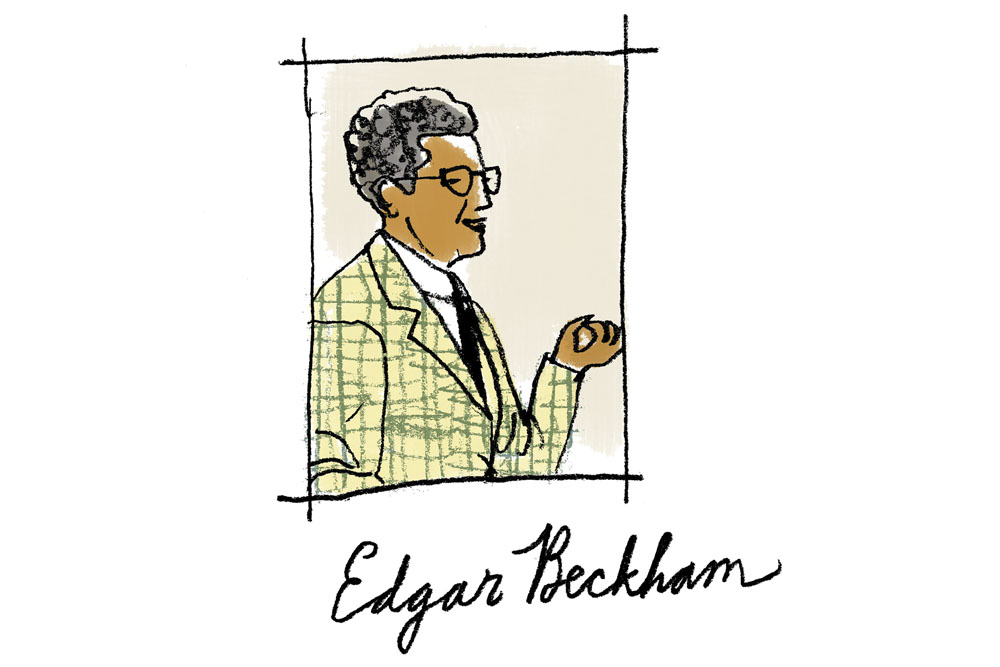 The latter half of the 1960s were years of great change on campuses across the country, but particularly at Wesleyan. The neatly groomed Wesleyan men of the ’50s, wearing jackets and ties to dinner at their fraternities, gave way to an altogether different campus ambience. The arrival of the Vanguard Class in 1965 (the first class of students recruited specifically for diversity as well as academic excellence) put Wesleyan in the forefront of nearly all-white colleges seeking racial diversity, but the road to equity and inclusion would be long and marked by significant unrest and controversy (a road Wesleyan continues to travel). The re-introduction of coeducation, with exchange and transfer
The latter half of the 1960s were years of great change on campuses across the country, but particularly at Wesleyan. The neatly groomed Wesleyan men of the ’50s, wearing jackets and ties to dinner at their fraternities, gave way to an altogether different campus ambience. The arrival of the Vanguard Class in 1965 (the first class of students recruited specifically for diversity as well as academic excellence) put Wesleyan in the forefront of nearly all-white colleges seeking racial diversity, but the road to equity and inclusion would be long and marked by significant unrest and controversy (a road Wesleyan continues to travel). The re-introduction of coeducation, with exchange and transfer  students in 1968 and first-year students in 1970, was an essential transformation for a small university. The number of undergraduates doubled in the next decade as gender equity was achieved without reducing admission of male applicants. Wesleyan embarked on an ambitious construction agenda, most notably the science complex and the Center for the Arts, but these major additions to campus came at a heavy price: Wesleyan’s finances were destabilized and the effects would be long lasting as the booming ’60s gave way to the stagnant ’70s.
students in 1968 and first-year students in 1970, was an essential transformation for a small university. The number of undergraduates doubled in the next decade as gender equity was achieved without reducing admission of male applicants. Wesleyan embarked on an ambitious construction agenda, most notably the science complex and the Center for the Arts, but these major additions to campus came at a heavy price: Wesleyan’s finances were destabilized and the effects would be long lasting as the booming ’60s gave way to the stagnant ’70s.
Uncharted Waters…
David Potts’s account ends in 1970, so after that time we don’t have the benefit of his meticulous research and great storytelling, replete with detail. Nor do we have as much historical perspective. Still, it’s apparent in retrospect that Wesleyan veered into relatively uncharted waters as the “little university,” distinct from its peers.
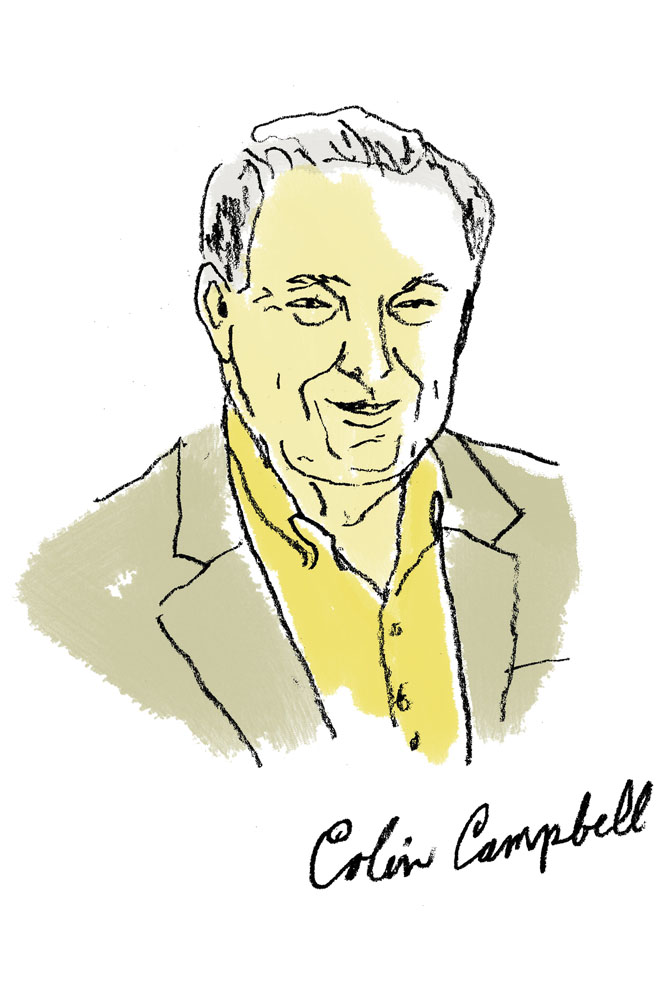 The first order of business in the early 1970s was to put Wesleyan’s finances in order, and here President Emeritus Colin G. Campbell left his mark on institutional history by providing a soft landing in difficult circumstances. Very early in his presidency, Campbell famously explained to the Wesleyan community that the rate of spending from the endowment would rapidly impoverish the institution if brakes were not applied. Campbell hit the brakes hard after a major review of policies and programs, but he also led the university’s first successful capital campaign in many decades, raising $63 million. By the early 1980s, Wesleyan’s finances had stabilized, and although it had lost its commanding financial lead over Amherst and Williams, the three institutions had rough parity in endowment. In subsequent years, insufficient endowment fundraising coupled with a high rate of spending from the endowment would seriously erode Wesleyan’s competitive position in this regard.
The first order of business in the early 1970s was to put Wesleyan’s finances in order, and here President Emeritus Colin G. Campbell left his mark on institutional history by providing a soft landing in difficult circumstances. Very early in his presidency, Campbell famously explained to the Wesleyan community that the rate of spending from the endowment would rapidly impoverish the institution if brakes were not applied. Campbell hit the brakes hard after a major review of policies and programs, but he also led the university’s first successful capital campaign in many decades, raising $63 million. By the early 1980s, Wesleyan’s finances had stabilized, and although it had lost its commanding financial lead over Amherst and Williams, the three institutions had rough parity in endowment. In subsequent years, insufficient endowment fundraising coupled with a high rate of spending from the endowment would seriously erode Wesleyan’s competitive position in this regard.
Wesleyan’s weakness in endowment, particularly as measured by endowment per student, hasn’t been without deleterious consequences. Hearkening back to Vic Butterfield’s words, however, it would be a mistake to fixate on this one competitive measure of a complex institution. The glory days of American Education Press and Xerox may be past, but Wesleyan’s capacity to raise funds is following a rapidly rising trajectory from the $281 million campaign led by President Emeritus Douglas J. Bennet ’59 to, most recently, the hugely successful THIS IS WHY campaign, led by President Michael S. Roth ’78, which raised $482 million from a much larger and wealthier alumni body. Thanks to fundraising, careful spending, and astute portfolio management, the endowment is just shy of $1 billion as this article goes to press. Wesleyan’s financial position is solid, and the number of applications for admission has been hitting new records in recent years.
President Fisk called on Wesleyan to send its graduates “into the world to make it better.” Now, 186 years later, the Wesleyan community can take pride in the way its alumni contribute to society in the public sphere, in the arts and sciences, as entrepreneurs in the digital world, as writers and performers, and as contributors to intellectual and cultural life in all fields. Above all, that is Wesleyan’s continuing story.
Thanks greatly to David Potts ’60, Suzy Taraba ’77, director of Special Collections and Archives, and Leith Johnson, university archivist, for their assistance in preparing this article.

